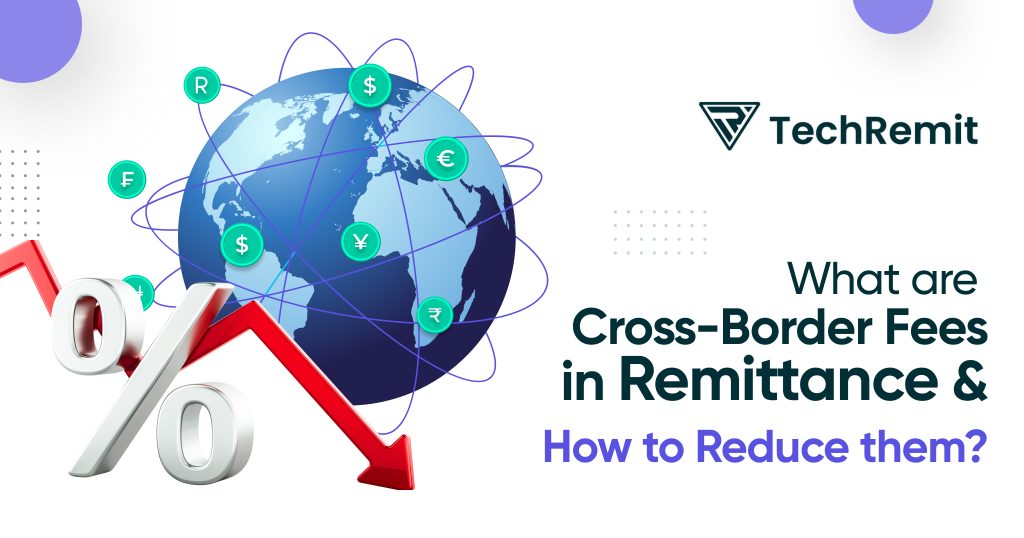What Are Cross-Border Fees In Remittance and How to Reduce Them?

Almost every financial transaction is subject to some type of fee, whether the sender and the receiver are aware of it or not. Besides, when the nature of the financial transaction is cross-border remittance, the fee associated with the transfer is much more complex due to the involvement of multiple factors as well as considerations.
Instead of a single charge, there are often multiple fees, which are actually important to make the cross-border transaction feasible. However, this complexity doesn’t mean that such fees cannot be minimized!
If you rely on cross-border financial transactions for business or personal reasons, you need to fully understand the fee structure involved and how to reduce it whenever possible.
Read this guide to learn everything you need to know about cross-border remittance fees and how to lower them.
Understanding Cross-Border Fees In Remittance
Cross-border fees are additional charges applied for processing international financial transactions. In the context of remittances, they refer to the total cost of sending funds from one country to another. These fees typically include transaction fees, intermediary charges, currency conversion costs, and so on.
All parties involved in a remittance transaction, such as issuing banks, currency exchange providers, payment networks, payment processors, and intermediaries, charge their respective fees.
A cross-border payment is processed and charged in the following way:
- The remittance platform initiates the payment based on the details provided by the sender.
- The payment network routes the transaction as per its destination country.
- Various fees are applied, including infrastructure, compliance, and regulatory charges.
- These charges are combined and presented as the total transaction cost.
As a result, this fee is charged not only to cover the costs of carrying out cross-border payments and currency conversions but also to manage the risk and ensure compliance. Since transactions are carried out in multiple countries, different currencies and regulatory frameworks must be taken into account in order to truly carry out successful cross-border payments.
Common Types of Fees in Cross-Border Remittance
Most cross-border remittance costs can be grouped into the following categories:
Transfer or Service Fees
This is the basic service charge that a remittance service provider charges for remittance services delivered through a comprehensive remittance infrastructure. They securely process the cross-border transactions in accordance with applicable regulations. Now, not all service providers charge the same fee, and the fee can vary depending on the transfer method (bank transfer, cash pickup, mobile wallet), as well as the country involved.
Currency Conversion Fee
Cross-border payments involve currency conversion from the sender’s country to the receiver’s country as per the exchange rate between the two currencies. However, some remittance service providers mark up the actual exchange rate. As a result, the exchange rate is less favorable than the mid-market rate, lowering the actual value of the transaction.
Intermediary or Correspondent Bank Fees
Sometimes, in order to make the cross-border payment possible, the transaction needs to be routed through multiple intermediary banks. Thus, unlike direct transfer, each intermediary bank would deduct processing charges from the transferred amount, increasing overall cross-border fees.
Receiving Fees
Well, it is not a mandatory fee, but some recipient banks charge for the incoming funds as well. However, recipient fees are usually absent when using digital remittance software.
Platform-Specific Fees
These are basically additional fees for add-on services. Some service providers charge additional fees for their specialized services, such as instant transfers or non-standard payout methods.
How to Reduce Cross-Border Remittance Fees?
Cross-border fees cannot be completely avoided, but they can be significantly reduced by following a few steps. Here are some practical strategies for lowering this fee:
Compare Different Platforms
No two platforms would charge the same fee for cross-border transactions. A genuine platform would have a transparent and genuine pricing model. However, traditional remittance service providers don’t disclose their fee structure and charge excessive fees.
There should be complete transparency on all charges that have a collective impact on overall cross-border transfer fees. Thus, make sure to compare and choose an online remittance platform with a clear fee structure that charges reasonable fees.
Send in the Recipient’s Local Currency
Make sure you are transferring the funds straight to the local currency of the recipient. It would help prevent the need for multiple conversions, which usually result in less favorable rates and additional expenses.
Consolidate Transfers
If you are a regular remitter who sends cross-border payments on a regular basis, you can try combining smaller transfers into larger transactions. This allows you to limit the number of times flat fees are charged for each transaction and lower overall cross-border costs.
Negotiate Rates for High Volumes
Furthermore, if you are a frequent remitter, you can demand that the remittance service provider give you additional discounts and negotiate better exchange rates or reduced fees. Many service providers value their loyal customers and gladly offer them generous discounts.
Monitor Exchange Rates
Stay updated on exchange rate fluctuations, as they have a huge impact on the actual value of the transferred amount. It would be beneficial to send your transfers when exchange rates are more favorable.
Explore Cryptocurrency Transfers
Cryptocurrency transfers facilitate peer-to-peer (P2P) cross-border transactions without the need for banks or any other intermediaries. This results in direct transfers and reduced cross-border fees. However, make sure to understand the market volatility and the fees involved in converting crypto back into local currency.
Wrapping Up
Indeed, sending money across borders will always involve some cost, but it doesn’t have to be expensive. By understanding the breakdown of the fees you’re paying, comparing providers that offer fair and transparent pricing, consolidating high-value transfers, and following the strategies mentioned in this article, you can significantly reduce unnecessary charges.
For more insights, practical tips, and the latest updates on remittance trends and fintech innovations, stay connected with Tech Remit.
Also Read : Importance Of Transparency, Speed, And Security In Cross-Border Payments